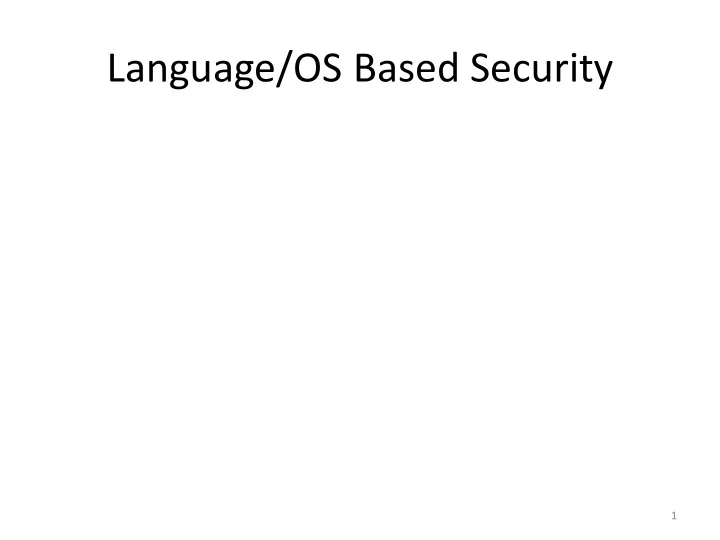

Language/OS Based Security 1
Infrastructure 2
Security Abstraction Layers 3
OS Security Control 4
Abstraction Imperfections • OS: Each process has exclusive access to its own CPU and memory – Illusion!! • A process may be able to detect that some of its memory is in fact swapped out to disk, based on the response time of certain operations. – Guess a password – early OS (TENEX) – Tarball problem in Solaris 5
Other factors • Software Bugs • Complexity • Safe programming Languages – Trusted Abstractions – Vs – Well defined precise semantics 6
Safety and Security • Memory Safety – pointer arithmetic; – unconstrained casting (e.g., casting a floating- point number to an array); – lack of array bounds checks; – programmer-controlled de-allocation (as this allows dangling pointers to memory that has been de-allocated). 7
Stronger Notion of Memory Safety • Guarantees: programs never read uninitialised memory. • Weaker definition of memory safety --programs are guaranteed to only access memory locations that they are permitted to access — – one can argue whether accessing uninitialised memory should also count as access that is not permitted. • One consequence of this is that programs cannot observe the old content of physical memory that other processes used previously. – Rules out possibility of spying other programs in the usual way – Consequence: iprograms behave more deterministically 8
Type Safety • Type: Impose restrictions on the programmer that avoid meaningless programs. – many safe languages are typed. • Not all safe languages are typed. – LISP is a safe, but untyped language 9
Type safety • Type soundness or safety or strong typing: i guarantee that executing well-typed programs can never result in type errors. – I.e., in a type-safe language we can rely on the abstractions offered by the type system. • Other PL Features – Visibility ( public, private … ) – Constant values and immutable data structures 10
Ensuring Type Safety • Overcome fundamental flaws: establish mathematically the correctness of type systems -- manual, theorem provers … • What does it means for a type system to be safe: difficulty either informally or formally – Operational semantics – Representation independence • Abstraction provided cannot be broken – see example 11
Example: Representation Independence • In a type-safe language it should be impossible to find out if the boolean value true is represented as 1 (or maybe a 32- or 64-bits word ending with a 1) and false as 0, or the other way around. • If we define two semantics of a type-safe language, one where true is represented as 1 and false as 0 and one where true is represented as 0 and false as 1, we should be able to prove that for any well-typed program the semantics are equivalent regardless of which of these two representations is used. 12
Thread safety • Safety concerns the execution of multi- threaded or concurrent programs • Security vulnerabilities when there is concurrent access to some resource, namely so-called TOCTOU (Time-of-Check, Time-of- Use) errors, also known as `Non-Atomic Check and Use' . 13
Thread Safety • A procedure, function, method - or generally, some piece of code - is called thread-safe if it can be safely invoked by multiple threads at the same time. • In an object-oriented language, a class is called thread-safe if multiple execution threads can simultaneously invoke methods on the same instance of that class. • one could define a programming language to be thread- safe if its semantics is well-defined in the presence of multi- threading. – Even a supposedly safe programming language such as Java is inherently unsafe when it comes to concurrency – if a Java program contains data races, it may exhibit very strange behaviour, and one cannot make any guarantees about the semantics whatsoever 14
Language Based Access Control • Language Platforms: – Modern programming language platforms (or `frameworks'), such as Java or .NET, provide an execution engine that is responsible for executing code, and – an API that exposes functionality of the platform itself and of the underlying operating system. 15
Language Platforms (1) • The API provides basic building blocks for programs (for example, java.lang.Object ), an interface to the underlying operating system (for example System.out.println ), and provides some components responsible for the security functionality of the platform (for example the java.lang.ClassLoader and java.lang.SecurityManager ). 16
Language Platforms (2) • The Java platform is officially called the Java Runtime Environment, commonly abbreviated to the Java Runtime. • It consists of the Java Virtual Machine and an implementation of the Java API. • The .NET framework also consists of a virtual machine, the Common Language Runtime or CLR, and a library, the .NET Framework class library. 17
Language Platforms (3): Access Control • The platform also performs access control where it treats different parts of the code (components) differently. • Separation between components and access control per component. 18
Security controls at programming platform level 19
Layers • Two layers of access contro: – One by the language platform – One by the operating system -- nice example of Defence in Depth . • One could in principle get rid of the whole operating system, or `hide' it under the language platform, so that the language platform is the only interface to the hardware for users and application programs. • Example: JavaCard smartcards. 20
Why do we need language based access control? • Modern applications: composed of code from different sources, not all equally trustworthy. • Example: – A Java applet: a Java program downloaded over the web and executed in a web browser; – clearly you do not want to execute this code with all the access rights of the user, or even the access rights of the web browser. – For example, your web browser can access the hard disk, but you don't want to give some applet on any web page that right 21
Recommend
More recommend